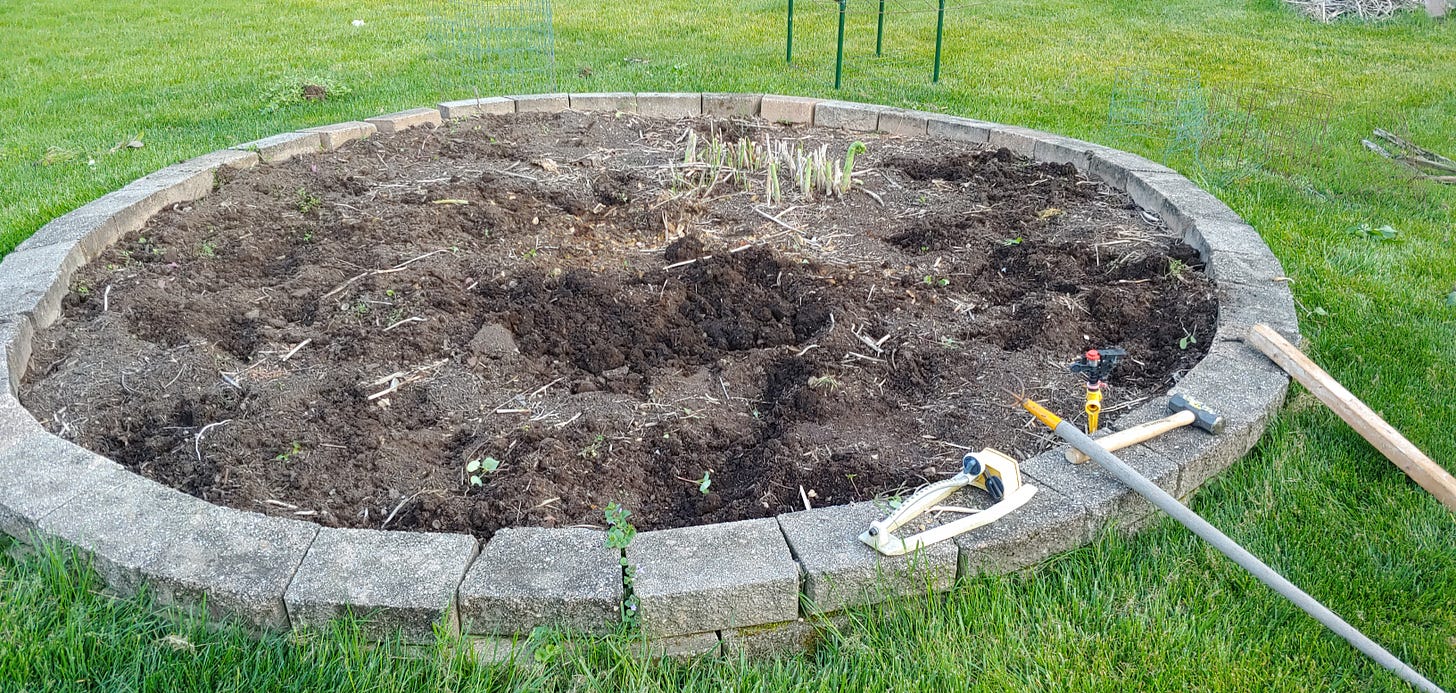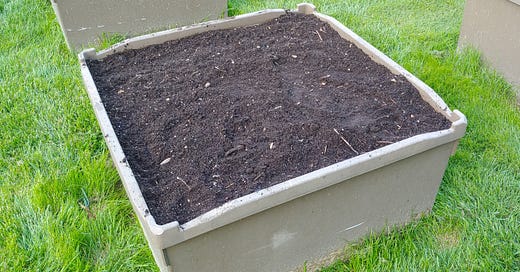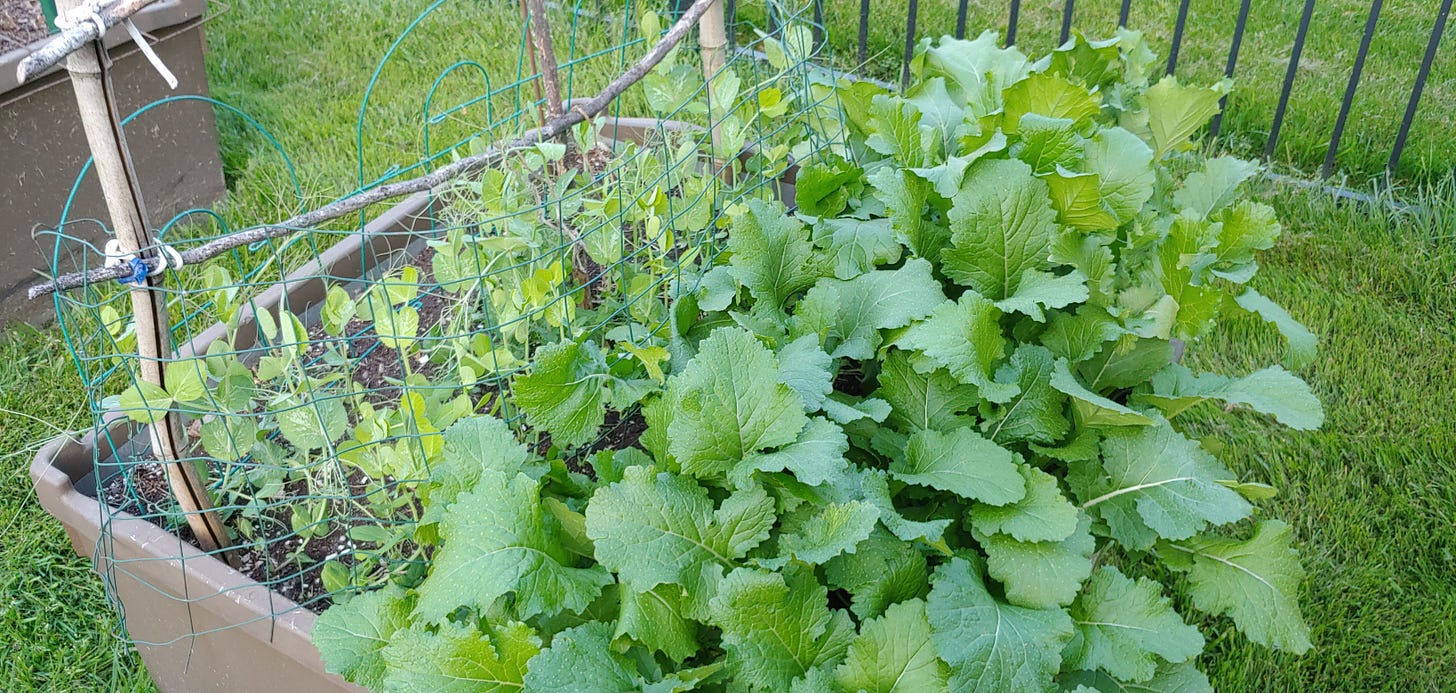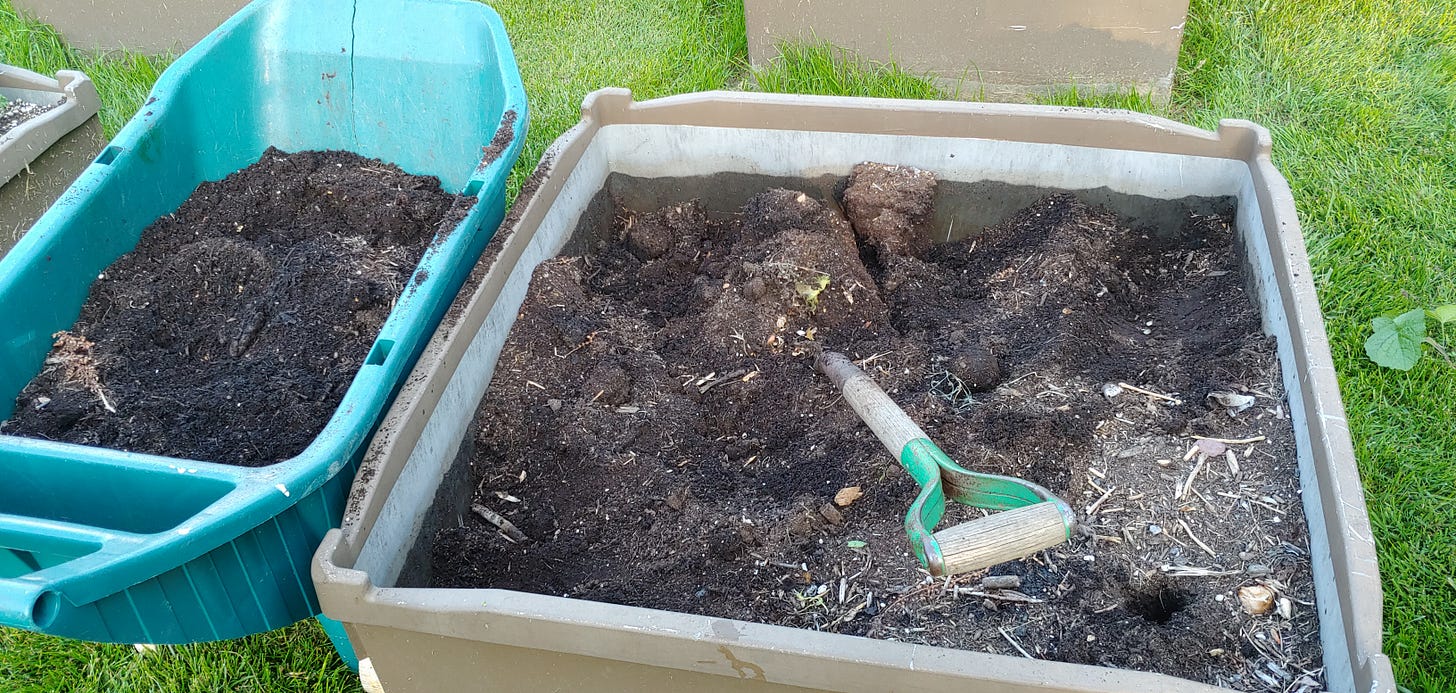Humans can be really good at missing the point sometimes. Gardeners, being people, are often so afflicted. I cry every time someone in my Facebook garden group asks “What kind of fertilizer should I use?”. Fortunately, the answer is always simple and straightforward: None! No fertilizer! You don’t need fertilizer!
Since the dark days when nineteenth century German chemists figured out how to turn plants into drug addicts, gardeners have been looking for shortcuts. And they miss the point. If your kid wants to be on the football team at school, you wouldn’t ask, “What kind of steroids should he use?” Your budding linebacker needs diet and exercise. And your garden needs soil and sun. So let’s skip the plant drugs and talk about soil.
Here’s a box just like the one above, filled with happy pea plants, turnip plants and broccoli rabe plants:
You know what is missing from this picture? Correct! — fertilizer. No fertilizer for the past twenty years. Just good soil, tended carefully spring and fall, to return what I have taken from it. No, I don’t throw peas and turnips into my soil. I give the soil the best diet and exercise there is for plants, and that prescription is yard waste compost. That’s it. Nothing else. Making and acquiring compost is a mammoth subject for another time. But you can rest assured that, by hook or by crook, I always have some on hand.
Of course, none of this is my point for today. I just wanted to get myself agitated. I write faster that way. I did want to talk about soil though, so let’s do that.
To dig or not to dig, that is the question. Whether ‘tis nobler in the yard to suffer the slings and arrows of outrageous shoveling, or to spread compost o’er a bed of dead soil, and by neglecting, feed it: to dig, to till no more; and by a rake, to say we end the backache, and the four tablets of ibuprofen that stomach awaits?
Okay, I’m not Shakespeare. But, admit it, you laughed.
If you’re not a real garden geek, you’re probably lost, so let me explain. A debate has been raging for years in home gardening circles about a technique called “no dig” or “no till”. Gardeners who subscribe to this don’t bother to till their garden soil; they just add soil amendments (mostly compost) to the top. Many people swear by it, the basic claims being:
It’s a lot easier on the back (true)
It keeps buried weed seeds deeply buried, thus reducing the number of weeds (eh, I don’t know, I get a lot of weeds regardless)
It keeps nitrogen from escaping the soil (yeah, I’m calling BS on that one).
Full disclosure, I have no real problem with no-till. As we will see, I actually practice a modified form of it in one part of my garden. My problem is the religious fervor that some (not all) practitioners adopt when speaking reverently of it (peace be upon it). This gets into yet another larger subject for another time, which is the way that certain issues in gardening adopt quasi-religious undertones, as though the ultimate disposition of one’s soul depends on them. And I can’t get all that worked up about such things. Sure, I’m a compost evangelist — guilty as charged. But in the end, if a gardener doesn’t want to use compost, I shake the soil off my sandals, place a curse on that garden and move on. Ooops, no, I don’t do that. I might think about doing that, but I’d never actually do it.
Okay, I’d never even think of doing that (well, until about thirty seconds ago…).
Alright, let’s reboot. What I’m trying to say is, sure, composting means a lot to me, but that’s because it works. It’s what’s for dinner …if you’re a plant. My fervor is not based on some story from afar that became transmogrified into an entirely different gospel in a different context. Take no-dig (please). No-dig in the garden world evolved out of a much larger and more serious “no- till” idea in the larger-scale farming world. That emerged because we really do have a problem in our civilization with soil erosion. To quote our current President from a decade or so ago, during his VP days, “This is a big effin’ deal.” Except he didn’t say effin’. And excessive tilling is part of the problem (not with potty mouthed politicians, with soil erosion).
No-till gardening has little or nothing to do with soil erosion. The true evangelists liked the compelling, soil salvation vibe that it had in the farming world, so they decided the gardening world needed a similar spirit of revival. So if you walk into the wrong garden these days, you might find a no-till evangelist praying over a kneeling penitent, rototiller shattered in pieces behind him, asking for forgiveness and the strength to follow a Better Path going forward.
No, you will never see that. But it sometimes sounds like that if you hang out in the wrong internet spaces.
Enough of that, let me get to the point: I’m a Tiller. There, I said it: An unrepentant Tiller (it sounds like a movement in fifteenth century Scotland, brutally suppressed by a Lancastrian king). I kidnap no-till people and tie them up and make them watch me till my garden soil until there is no clump in sight, all while screaming “Repent infidel! Repent!”
No, I don’t do that. Mostly, I just shrug (by the way, remember this little ditty? → ¯\_(ツ)_/¯ - that was cool, wasn’t it?). You know, I actually have nothing against no-till. As I said, I practice it here and there. My irritation mushrooms when people insist that it is the only method that a sane, reasonable and spiritually fulfilled human could possibly ever consider using to manage his or her garden soil. And that’s bunk. Whatever bunk is. It can’t be good.
So I thought I’d give you examples of why I till sometimes and why I don’t till other times (spoiler alert: the latter has more than a little to do with laziness).
As some of you readers know, most of my garden consists of a dozen large, fiberglass boxes (as pictured earlier). Like a few other things in this post, the story of those boxes is lore for another conversation. For now, assume I acquired them legally.
So these boxes are filled with the best soil that money can’t buy. It remains that way year after year because I add compost to them before and usually after every planting. And, yes, I dig. I realize that this is the equivalent of a knight who says “Ni!” to some ears, but that’s life. Persevere. You’ll live. So let me explain one of multiple reasons why I might need to dig (Dig! Dig! Stop Tom, stop! — I demand a shrubbery…).
It’s spring, and I have a few boxes with lower soil levels. They need compost. But I need to plant seeds. And the available compost is, let’s just say, “a little chunky” this spring (it’s not quite finished). Just take my word for it, you don’t want to sow seeds in chunky compost. So what do I do? Next slide please:
I give you Exhibit A: A garden box with the top layer of soil removed. So why in the world would I do that???
Well, that brings us to Exhibit B: A garden box with the aforementioned top layer of soil replaced by some chunky compost:
And, finally, Exhibit C: A garden box with a layer of chunky compost covered by a layer of nice soil previously removed:

So now I have a compost sandwich — soil above and below, with a thick layer of compost in between. Mmmm. The compost will be unrecognizable as such in a month or so, and, in the meantime, my seeds will be much happier in the nice soil on top. This solution brought to you by the Brotherhood of Garden Diggers Local #497634. Amen.
Lest this post seem unbalanced, and the sarcasm one-sided, I now give you Exhibit D: Round raised bed that exists because I was too lazy to remove a tree stump about fifteen years ago:

It’s a nice little bed. I rotate my tomatoes into it every third year. That stuff growing near the back is my tiny little asparagus patch (yet another story for another time). In any case, please don’t tell anyone from the Brotherhood of Garden Diggers Local #497634, but I don’t dig this bed. Well, I do dig it. I mean, I like it. But I don’t dig dig it. I mostly just spread a layer of compost over it every year …after removing all the weeds that the no-dig folks keep telling me don’t exist. Sigh. Anyway, this works too. Because the moral of the story is, if you send all your fertilizer to that great fertilizer dump in the sky, and start using good compost instead, it pretty much doesn’t matter what you dig or don’t dig. And that is a pretty big effin’ deal, Joe.








